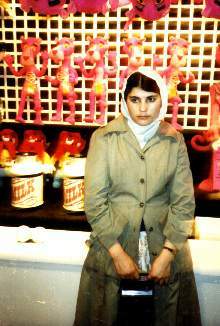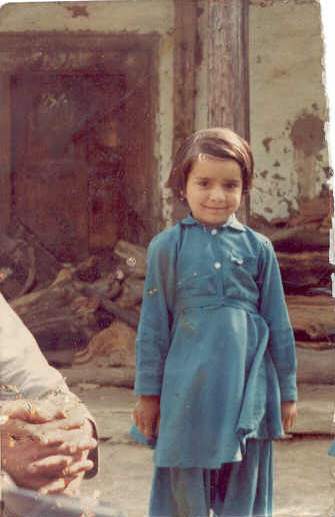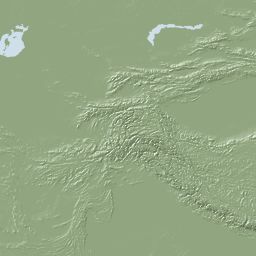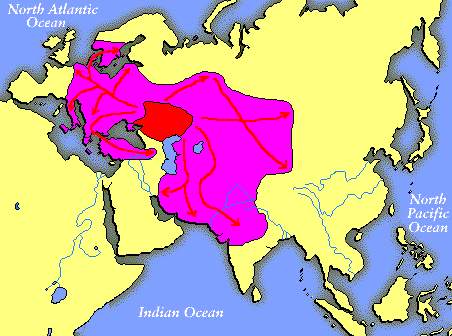





I have long been fascinated with the region of Chitral in Northwest Pakistan. I even married a woman there and I have a baby from there. I first visited the place in 1978 because I read an article about it in National Geographic Magazine.
The reason for interest is that Chitral is inhabited by a European looking tribe. Because Chitral and neighboring Nuristan are populated by white skinned people who look like they came from Europe, whereas they are surrounded by darker skinned Indian people, this has given rise to the legend that that are descended from the soldiers of Alexander the Great, who passed by the area in 327 BC. An additional factor is that before most of them were converted to Islam, the Chitralis and Nuristanis had a system of gods and goddesses similar to the Greeks. There is a movie, The Man Who Would Be King, starring Sean Connery, that is based upon this legend.
However, that theory is debunked by the fact that the histories of Alexander the Great report that the light skinned people where already there before Alexander got there.
Norwegian linguist George Morgensteirne spent years studying their language and concluded that they speak one of the most archaic forms of the Indo European family languages, suggesting that they had been speaking that language for the last four thousand years. This led to the widely accepted conclusion that the Chitralis and Nuristanis were in the earliest wave of Indo European Invaders 4,000 years ago and that they made a wrong left turn at Jalalabad, ascended the Kunar River and got stuck high in the Hindu Kush Mountains of Chitral.
However, a new theory has just emerged. Hard to believe and at first it seems ridiculous, but DNA evidence suggests that the immigration went the other way. The people of Western Europe and most especially the people of England are originally from Chitral !!!!
To see this, take a look at the new Genographic map on the National Geographic website at https://www5.nationalgeographic.com/genographic/atlas.html
Click on Genetic Markers at the bottom of the page and then click on M9.
Now you will see a blue arrow pointed north. That blue arrow ends at the Broghol Pass in the upper extreme of Chitral. Broghol Pass crosses the Pamir Knot.
Now, click on the faint blue line above it. That is M45.
You will see that it curves West, after passing through Central Siberia.
Now, click on the next blue line, which is M173.
You will see that it crosses the Ural Mountains and reaches Eastern Europe.
The next line this leads to is M343. That line passes through Europe and ends on the north coast of Spain.
The explanation given for this is that M343 came through Europe during the Ice Age. England was covered with ice. However, as the ice receded, the M343 people in France and Northern Spain moved over to England. Today, England consists 70% of M343 people.
This map is the product of Dr. R. Spencer Wells. When I first saw the map, I did not believe it. I have been trying to find out how to contact Dr. Wells to find out if he fully understands the implications of his map. I was not even certain that he realizes that his map shows an immigration up the Chitral River and across the Broghol Pass through the Pamirs into Tajikistan. I know his map shows this because I have been there and I know that the Broghol Pass is the only reasonable way to cross the Hindu Kush Mountains by following his map.
I have not been able to reach Dr. Wells to ask him this, but I have read in his biography that he has been taking DNA samples of the Tajiks who live directly north of the Broghol Pass, so he must be on the scent. I do not know if he has DNA tested the Chitrais who live on the south side, however, but I assume that he must have, as his map so indicates.
The conclusion his map shows is that the first ancestor of all people who live outside of Africa today was a man known as M168. He or his descendants made it across the Red Sea to what is now Yemen.
The next man was M89 who evolved or mutated from M168. The next group were descendants of M89, who crossed the Arabian Peninsula and reached Iraq.
The next mutation was M9. His tribe crossed Iran and Afghanistan and branched out in different directions, one branch going north to Chitral.
At the point of crossing Pamirs by way of the the Broghol Pass into Tajikistan a new mutation developed called M45. He led to M173 and then to M343, who now resides primarily in England. The modern populations of Southern and Eastern Europe are not M343. They come mostly from a more recent migration that crossed Turkey and what is now Greece and Bulgaria or else crossed Georgia and the Caucasian Mountains.
The big problem for all of this is the time line. The most recent Ice Age ended 15,000 years ago. Did these migrations take place before, after, or during that Ice Age?
There were people in Europe long before M343 arrived. The Neanderthals were there. However, it is now believed that the Neanderthals died out earlier or else were wiped out by the arriving M343. The Neanderthals were bigger in size and with bigger brains than we have, but it is believed that they could not speak and so could not compete with us.
What I am proposing is a new theory. I say that I am proposing this theory because Dr. Wells has not yet proposed it although it is based on his data. Indeed, there seems to be no other reasonable conclusion.
My theory is that modern man did not reach Europe 35,000 years ago as Dr. Wells and others have stated. Rather he reached Europe only 15,000 years ago, as the ice from the Ice Age was receding. That puts the arrival of the first modern Europeans at about 15,000 years ago which is the same time that the first American Indians were reaching America. All this happened because the ice was melting worldwide.
What this suggests is that the modern Chitralis and Nuristanis were NOT among the first wave of Aryan Invaders who swept down from Uzbekistan, who crossed Afghanistan and who eventually conquered India. To the contrary, the Chitralis have been where they are today for the last 15,000 years. They were the ones who were left behind, as their brothers crossed the Pamirs at Broghol Pass. On the north side of the Broghol Pass is the Amu Darya River which flows into the Aral Sea. The distance from the Chitral River on the South Side of the Broghol Pass to the Amu Darya River on the North side is only eight miles. The Chitral River flows west but then curves south and joins the Indus River. A few hours easy walk over that pass that is only 12,000 feet high enables one to cross the great Pamirs and to cross from the Indian sub-continent into Central Asia. The Broghol Pass crosses the continental divide. There are other passes but Broghol is by far the lowest, the easiest and the most likely to have been crossed. Broghol Pass is located at 36_52_50_N_73_20_46_E_. Satellite Maps showing the exact location of the Broghol pass can be seen by clicking here.
Once on the north side of the Broghol Pass one reaches open plains filled with wild game and horses. It was because of the great abundance of wild houses there that Genghis Khan was able to conquer the territory all the way from China to Eastern Europe. An expert horseman, Genghis Khan and his armies could cross thousands of miles on horseback all the way from China to Europe in just a few months. The men who lived 14,000 years ago could obviously have done the same thing and indeed this must have been exactly what they did.
It is very cold north of the Broghol Pass. Modern men could live there because they were able to make their own clothing. Neanderthal men could not make their own clothing. For that reason, no Neanderthal skeletons have been found in that area, whereas many Neanderthal skeletons have been found in Europe.
One contrary issue which I must address is the difficulty of reaching the Broghol Pass. I never got that far but I did come near to it. It is a long walk, 200 miles up the Chitral River. There is little water there. Lots of snow, ice and glaciers, but all of that is all frozen. The altitude is high. Not much vegetation. I got discouraged and turned back. It is difficult to imagine a large scale migration across the Broghol Pass. However, it did not take a large scale migration. All that was required was a few men and women to make the trip. It is an easy walk. No mountains to climb. Just one 12,000 foot high pass to cross. Just a handful of people could be the ancestors of almost everybody who lives in England today.
These markers such as M343 and M45 are all Y-Chromosome markers, carried only by men. They show how men migrated and populated the Earth. Presumably, women accompanied the men on their journeys, but not necessarily. The women may have already been there from previous migrations when the new men arrived. It has long been believed that there was an Aryan invasion of India four thousand years ago. The men came from north of the Caspian Sea, crossed Afghanistan, conquered India, killed all the men there and mated with the women, thereby producing a new race which we call Indians. This happened four thousand years ago before reading and writing were invented, so there is no written or historical record of these great events. We find evidence of this in the languages of India which are closely related to the languages of Europe and hence are called Indo-European Languages.
The figure of four thousand years has been based on the calculation or estimation of how long it would take for one original Indo-European Language which was spoken by people who had horses (because the word for horse is similar in all Indo-European languages) to break up and evolve into the wide varieties of Indo-European Languages spoken today.
However, the newly taken and still being collected DNA samples do not seem to support this long held hypothesis of an Aryan Invasion. European Men do not have the same Y-Chromosome as Indian Men. Therefore, these Aryan Invaders did not kill all the Indian men and f their women. We have to come up with a new theory.
The new theory should be centered around the Pamir Knot. It is not only M343 that comes from there. There is a much more recent group, the Finns and Hungarians, who carry the LLY226 marker. They are recent arrivals in Europe, but they also originate from the north side of the Pamir Knot.
Most Chinese and Japanese are M122, which was derived from M175, which came through India.
M130 is an interesting group. It left Africa before the M45 Group but traveled along the coastline, not venturing far inland. It came around the coast of India, went down to Malaysia, then up the coast of China and Siberia and finally crossed to Alaska eventually reaching California.
This is a real problem. It seems unlikely that any group could have left Africa 50,000 years ago, but got to California only 6,000 years ago and experienced no major mutations along the way. It is basically impossible.
However, this discrepancy is solved by my theory, which is this all happened more recently, leaving Africa not more than 20,000 years ago, arriving in India not more than 15,000 years ago and then spreading out very rapidly, with different tribes populating Western Europe and the Americas at about the same time.
How the Chitralis fit into this is that they have a European appearance. Their religion contains a pantheon of gods and goddesses similar to the religion practiced by the ancient Greeks and Romans. This religion is only practiced by 3,000 Kalash today, but the people of Chitral say that all the people of Chitral and Nuristan practiced this old religion before the arrival of Islam a few hundred years ago. Chitralis speak the Khowar Language which is regarded as the most archaic form of the Indo European Family of Languages still spoken today. Finally, Chitral stands at the gateway to the Pamir Knot and thus, if the map is correct, most modern English had to cross Chitral in order to reach their home in Europe today. (Most other non-English Europeans came by a different route.)
Any questions?
Sam Sloan
Here are links: